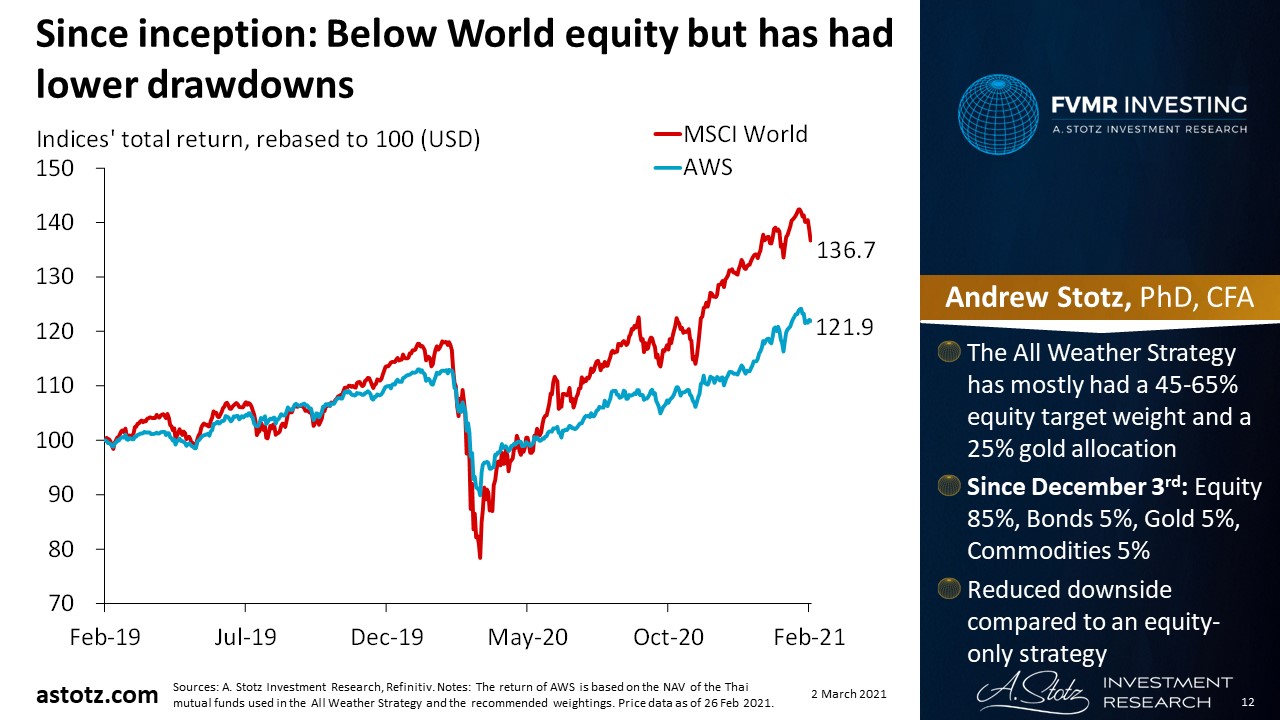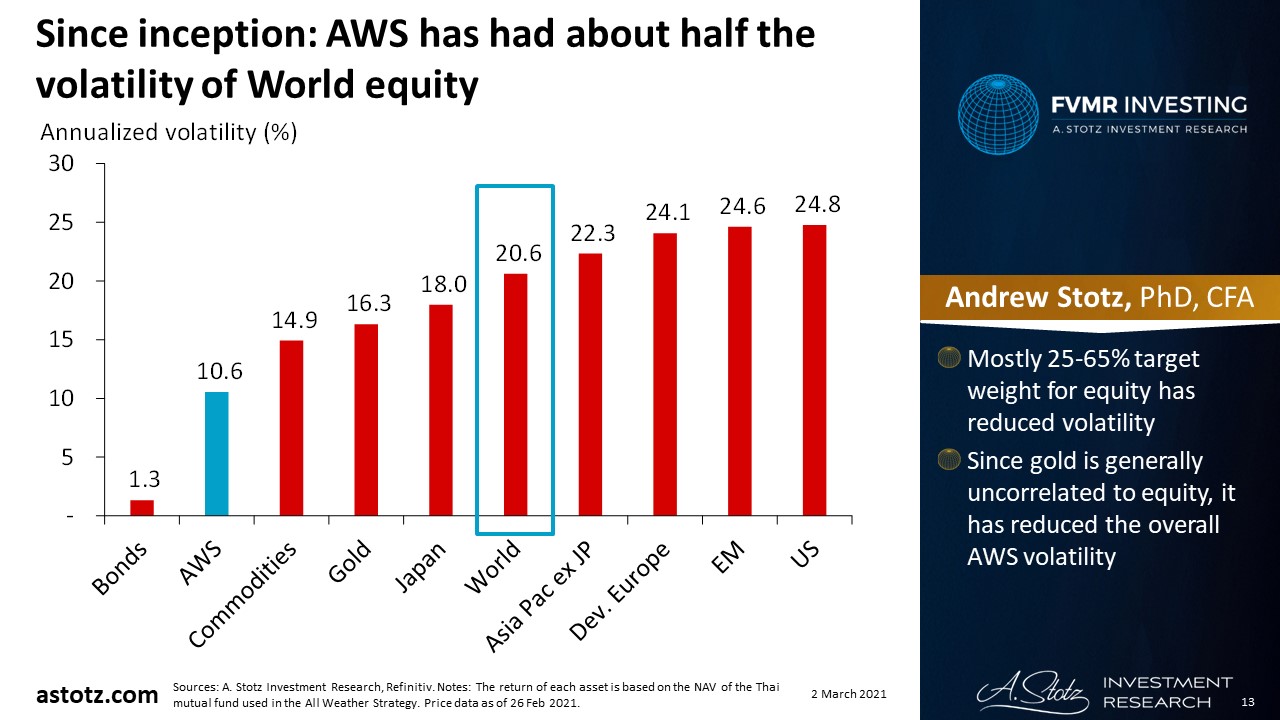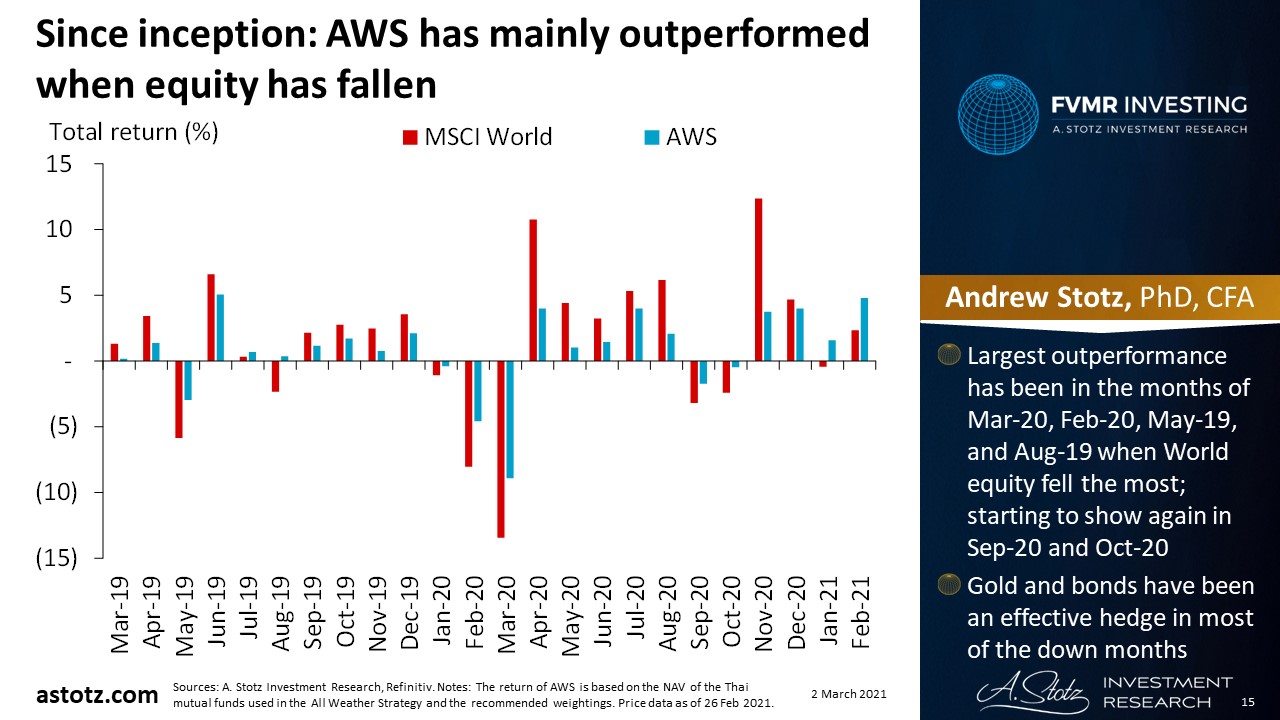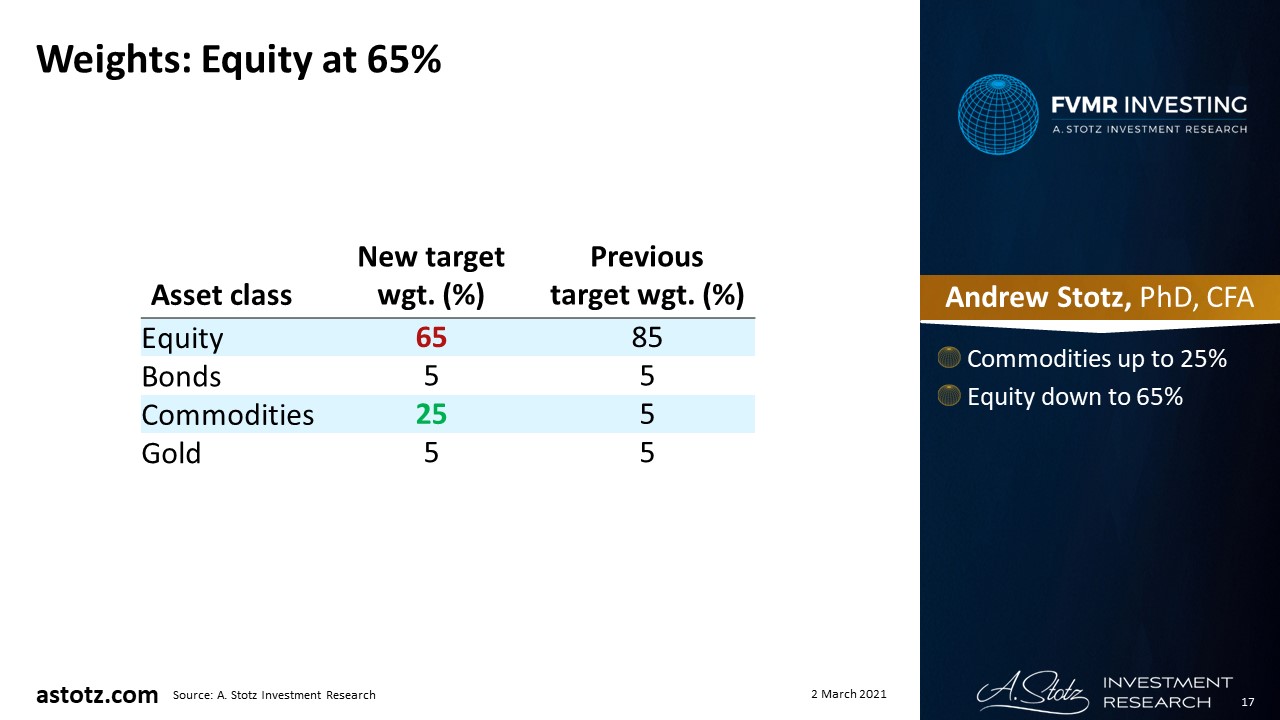A. Stotz All Weather Strategy – February 2021
The All Weather Strategy outperformed significantly in the past three months. Stimulus and vaccine news drive inflation expectations. We increase our commodities allocation to 25% and continue to overweight Asia Pacific ex Japan and Emerging markets.
The A. Stotz All Weather Strategy is Global, Long-term, and Diversified:
- Global – Invests globally, not only Thailand
- Long-term – Gains from long-term equity return, while trying to reduce a portion of losses during equity market downturns
- Diversified – Diversified globally across four asset classes
Celebrating 2 years of our All Weather Strategy with FINNOMENA!
- The All Weather Strategy has now been up and running at FINNOMENA for 2 years
- We’re grateful to all the investors who have put their trust in us
- We’re also thankful to FINNOMENA for offering the opportunity to make the strategy available as a GURUPORT
The All Weather Strategy is available in Thailand through FINNOMENA. Please note that this post is not investment advice and should not be seen as recommendations. Also, remember that backtested or past performance is not a reliable indicator of future performance.
Review
Max equity allocation helped the strategy to outperform
- In the past three months, equity markets performed strongly
- In the past revision, we increased our equity allocation to 85%, the strategy maximum
- Emerging markets outperformed Developed markets
Asia Pacific ex Japan and Emerging markets were the best within equity
- We had a 25% target allocation to Asia Pacific ex Japan and Emerging markets, which led to the strategy’s outperformance
- The US was the worst-performing equity market, which dampened the All Weather Strategy’s return
Low bond target allocation at 5% was the right decision
- In the previous revision, we kept our bond target allocation at 5% as due to the risk of rising interest rates they appeared less attractive relative to equity
- The strategy is to hold only Thai government bonds, rather than a mix of global government and corporate bonds
Commodities performed the best
- Our commodities target allocation remained at 5% in our latest revision
- In the past three months, energy and industrial metals did well as the industrial part of the global economy resumed its rebound
- Increased inflation expectations drove price
- Some agricultural commodities performed well as demand from China was strong
Gold was the worst performer in the past three months
- Our commodities target allocation remained at 5% in our latest revision
- In the past three months, energy and industrial metals did well as the industrial part of the global economy resumed its rebound
- Increased inflation expectations drove price
- Some agricultural commodities performed well as demand from China was strong
Past 3 months: Max allocation to top-performing equity markets drove outperformance

Past performance should not be taken as an indication or guarantee of future performance, and no representation or warranty, expressed or implied is made regarding future performance.
- All Weather Strategy: Outperformed World equity by 3.2%
- Asia Pacific ex Japan: Best performing equity
- Emerging markets: Second-best performing equity
- US: Worst performer among equity markets
Since inception: Below World equity but has had lower drawdowns

Past performance should not be taken as an indication or guarantee of future performance, and no representation or warranty, expressed or implied is made regarding future performance.
- The All Weather Strategy has mostly had a 45-65% equity target weight and a 25% gold allocation
- Since December 3rd: Equity 85%, Bonds 5%, Gold 5%, Commodities 5%
- Reduced downside compared to an equity-only strategy
Since inception: The All Weather Strategy has had about half the volatility of World equity

Past performance should not be taken as an indication or guarantee of future performance, and no representation or warranty, expressed or implied is made regarding future performance.
- Mostly 25-65% target weight for equity has reduced volatility
- Since gold is generally uncorrelated to equity, it has reduced the overall strategy’s volatility
Since inception: Has lost less when World equity has fallen

Past performance should not be taken as an indication or guarantee of future performance, and no representation or warranty, expressed or implied is made regarding future performance.
- A key feature of All Weather Strategy is that it aims to lose less when equity markets fall
- Looking at the 10 worst days of World equity since the inception of All Weather Strategy, the strategy has lost less on every bad day so far
- Due mainly to low equity weight; high gold allocation
Since inception: The All Weather Strategy has mainly outperformed when equity has fallen

Past performance should not be taken as an indication or guarantee of future performance, and no representation or warranty, expressed or implied is made regarding future performance.
- Largest outperformance has been in the months of Mar-20, Feb-20, May-19, and Aug-19 when World equity fell the most; starting to show again in Sep-20 and Oct-20
- Gold and bonds have been an effective hedge in most of the down months
Weights
Reduce target equity allocation to 65%, increase commodities to 25%
- Reduce equity exposure to 65% from 85%
- Increase weight in commodities to 25% from 5%
- Keep bonds and gold at 5% each
- Keep 25% allocation in Asia Pacific ex Japan and Emerging markets equity
- Reduce US equity weight to 5% from 25%
Equity at 65%

- Commodities up to 25%
- Equity down to 65%
Keep overweight in Asia Pacific ex JP and Emerging markets, reduce the US

- Keep 25% allocation in Asia Pacific ex Japan and Emerging markets
Reduce the US to 5%
Outlook
Reflation starts to show in US Treasury yields
- Vaccine and stimulus news can drive up inflation further
- Biden’s US$1.9trn stimulus plan is in the making, recently passed by the House of Representatives
- Rising yields on 10-year US Treasuries shows that the market expects inflation
And in European yields
- EU has seen a jump in inflation but doesn’t appear to be as close to overshooting as the US
- The European Commission’s recovery program is €750bn, so just about half the US’
- European yields have started to move as well
Fed and ECB to allow excessive inflation
- Fed and the ECB are open to overshoot their inflation targets due to undershooting for a long time
- This could drive inflation expectations further
- At least in the short-term, we think inflation is likely to rise
- Some will be from the COVID-19 base effect
China drives demand in Asia and Emerging markets
- China’s strong demand recovery to continue, positive for Asia and Emerging markets
- This demand recovery could also drive commodities further
- Strong commodities are usually good for Emerging markets
- We prefer Asia Pacific ex Japan and Emerging markets within equity
Inflation to support commodities
- Increased inflation expectations could be positive for gold and commodities
- We have raised the commodities target allocation to 25% to get exposure to this reflation theme
Rising real rates push down gold
- In the longer term, as the inflation narrative spreads, it could lead to expectations of negative real rates
- However, what we have just seen, is that real rates are up
- Rising real rates are the worst enemy of the gold price; hence, we stay with a low allocation
Long-term issues remain
- The US remains overvalued, and US gov’t debt is growing every day
- Even when COVID-19 is under control, many concerns remain
- Geopolitical tensions and mass unemployment
- Our equity allocation is now at 65%, down from the maximum of 85%
Regional Equity FVMR Snapshot

- Fundamentals: US has the highest ROE by far
- Valuation: Emerging markets have the lowest PE and Japan lowest PB
- Momentum: Emerging markets up the most in the past year
- Risk: Lowest gearing is found in Asia Pacific and Japan
Risks
The Fed does something drastic
- Though we are positioning the strategy to benefit during our expected inflationary (rising interest rate) environment, there are risks
- The biggest risk is that the US Fed prevents long-term US bond yields from rising, and this rallies the US stock and bond market
DISCLAIMER: This content is for information purposes only. It is not intended to be investment advice. Readers should not consider statements made by the author(s) as formal recommendations and should consult their financial advisor before making any investment decisions. While the information provided is believed to be accurate, it may include errors or inaccuracies. The author(s) cannot be held liable for any actions taken as a result of reading this article.
